The Earth’s geological history is a tale of timeless wonder, carved in stone and etched across continents. In this article, we invite you to embark on a globe-spanning journey, unveiling the secrets of our planet’s most incredible rock formations. These remarkable structures, shaped by the relentless forces of nature over millions of years, stand as silent witnesses to the ever-changing landscape of our world.
1. Ayers Rock (Uluru), Australia
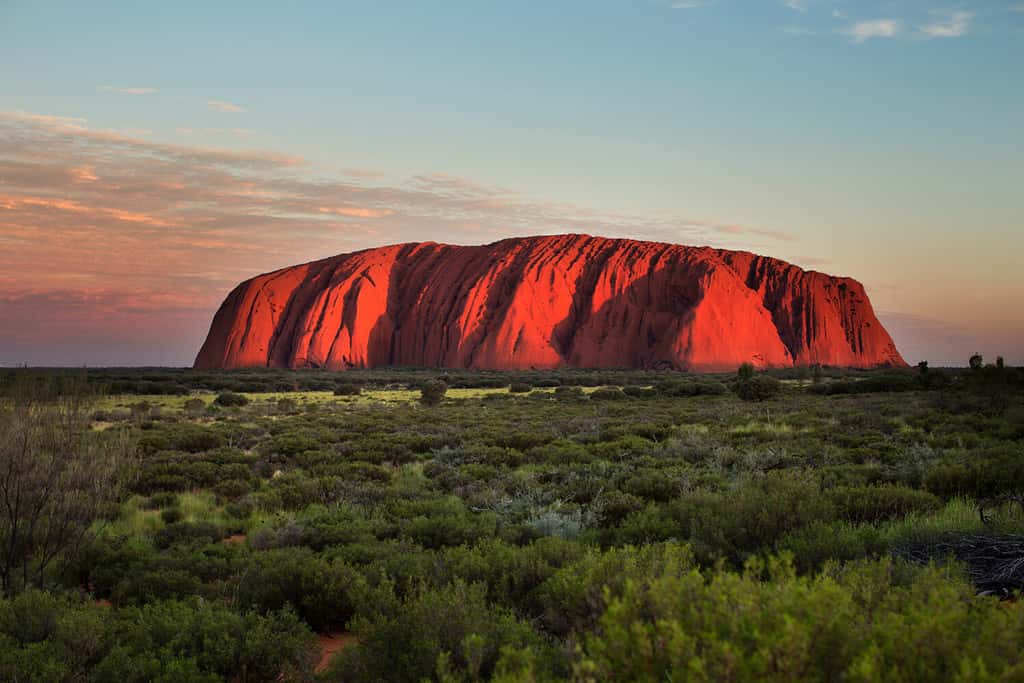
Standing tall at 863 meters (2831 feet), Uluru has a history that spans around 550 million years.
©eo Tang/Shutterstock.com
First, Ayers Rock, more reverently known as Uluru, is an extraordinary geological formation that graces the Australian landscape with its breathtaking presence. Located in the Red Centre of Australia, this colossal sandstone monolith has earned its place as one of the world’s most iconic natural wonders. Standing tall at 863 meters (2831 feet), Uluru has a history that spans around 550 million years, shaped by geological forces and time. Furthermore, it emerges dramatically from the arid, ochre-hued desert terrain, its sheer mass and deep-red coloration serving as a striking contrast to the vast Australian Outback.
However, Uluru is more than just a remarkable geological feature; it holds profound cultural significance for the Indigenous Anangu people. The Anangu have lived in harmony with this land for thousands of years and regard Uluru as a sacred site, rich with spiritual and ancestral significance. Moreover, visitors who explore the base of Uluru will encounter ancient rock art, caves, and waterholes. Each of these reveals a deeper layer of its cultural and geological heritage. Finally, as the sun’s rays dance upon the surface, shifting its colors from fiery red to softer, deeper shades, Ayers Rock stands as a living testament to the interplay of natural beauty, cultural heritage, and geological history, making it a true jewel of the Australian Outback.
2. The Giant’s Causeway, Northern Ireland
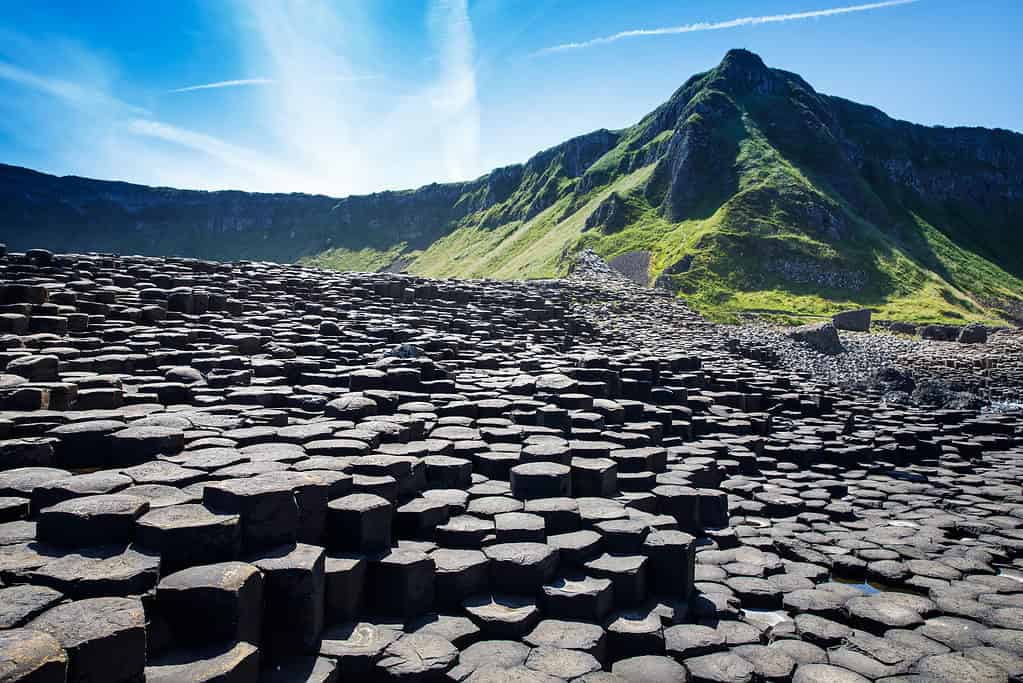
What makes this site truly remarkable is its astonishing basalt columns, numbering over 40,000.
©iStock.com/romrodinka
Nestled along the rugged and enchanting coast of Northern Ireland, the Giant’s Causeway is a geological masterpiece that seems straight out of a fantastical tale. This UNESCO World Heritage Site has long captured the imagination of visitors from around the globe. What makes this site truly remarkable is its astonishing basalt columns. Numbering over 40,000, they form a captivating pavement of hexagonal stones. The formation of these interlocking columns is the result of volcanic activity that occurred nearly 50 million years ago. As molten lava met the cold waters of the North Atlantic, it rapidly cooled and solidified. This, in turn, created the hexagonal shapes that have enthralled visitors for centuries.
Moreover, steeped in Irish folklore and mythology, the Giant’s Causeway has a rich and whimsical history. According to legend, it was built by the Irish giant Finn McCool as a pathway to Scotland. There, he intended to challenge the Scottish giant, Benandonner. However, upon seeing the enormous size of Benandonner, Finn McCool cleverly retreated and enlisted the help of his wife. Ingeniously, she disguised him as a baby. The Scottish giant, seeing the “baby,” assumed that Finn must be even more colossal and fled back to Scotland, destroying the Causeway behind him. While this legend may not be rooted in geological fact, it adds a layer of enchantment to an already mesmerizing location. Ultimately, the Giant’s Causeway invites travelers to explore the wonders of the natural world and the depths of human imagination.
3. Mount Rushmore, USA

Mount Rushmore features a colossal sculpture carved into the granite in the Black Hills in Keystone, South Dakota.
©Ultima_Gaina/iStock via Getty Images
Nestled within the Black Hills of South Dakota, Mount Rushmore stands as a monumental tribute to American history and an enduring symbol of national pride. This colossal rock sculpture, perched on the side of Mount Rushmore, features the chiseled faces of four of the most revered presidents in U.S. history: George Washington, Thomas Jefferson, Theodore Roosevelt, and Abraham Lincoln. This extraordinary undertaking, led by sculptor Gutzon Borglum, began in 1927 and took over 14 years to complete. The vision behind Mount Rushmore was to honor the ideals and leaders that have shaped the nation’s destiny.
What’s more, Mount Rushmore’s location within the Black Hills holds additional significance. This region is considered sacred land to the Indigenous Lakota Sioux. The carving of these iconic faces onto the mountain’s granite surface is a testament to the complex relationship between cultures and histories that have woven the fabric of the United States. Today, Mount Rushmore continues to inspire visitors from all corners of the globe. Furthermore, it serves as a reminder of the values and principles that have defined the nation’s character. It stands as a remarkable feat of artistry and engineering, harmoniously blending history, culture, and natural beauty into an enduring symbol of American identity.
4. The Wave, Arizona, USA

The Wave is a geological wonder that seems plucked from the realm of dreams.
©Katrina Brown/Shutterstock.com
Next, nestled within the heart of Arizona’s Vermilion Cliffs National Monument, The Wave is a geological wonder that seems plucked from the realm of dreams. This sandstone formation is celebrated for its undulating, swirling patterns, creating a surreal and mesmerizing landscape. What makes The Wave particularly unique is the intricate process of its formation. Over the course of countless millennia, the sandstone layers have been sculpted by the forces of wind and water. This, in turn, gave rise to a dreamlike masterpiece. The result is a series of delicate curves and ridges, revealing an extraordinary blend of colors and textures as if painted by an artist’s hand.
Access to The Wave is tightly regulated due to its fragile nature and to preserve its pristine beauty. Only a limited number of daily permits are issued, ensuring the conservation of this natural wonder. Furthermore, the formation’s surreal beauty, with shades of red, orange, and yellow splashed across its surface, invites photographers, hikers, and nature enthusiasts to explore its winding paths and marvel at the artistry of the Earth’s geological processes. Finally, the Wave stands as a testament to the patience of nature and the magic that can be found in the remote and untouched corners of the world.
5. The Grand Canyon, USA

This geological wonder has become a UNESCO World Heritage Site and is visited by millions each year.
©ipanacea/iStock via Getty Images
The Grand Canyon, often described as nature’s masterpiece, is an awe-inspiring testament to the power of erosion and the majestic forces of the Colorado River. Over the course of nearly six million years, this remarkable geological formation has been carved into the Earth’s surface. Furthermore, this process exposed layers of rock that date back over two billion years. Its immense scale is difficult to comprehend. The Grand Canyon stretches for 277 miles (446 km), with a width that can reach up to 18 miles (29 km) and depths plunging over a mile (1,857 m) into the ground. What’s more, it’s a site that elicits profound wonder and contemplation. As one gazes into its vast expanse, it reveals the intricate story of Earth’s geological history.
Beyond its geological importance, the Grand Canyon is also a place of immense natural beauty. It teems with diverse ecosystems, plant and animal species, and unique microclimates. The varying colors of the rock layers, the rugged terrain, and the ever-flowing Colorado River add to its mesmerizing charm. Furthermore, this geological wonder has become a UNESCO World Heritage Site and is visited by millions each year. It offers a glimpse into the Earth’s enduring ability to shape, shift, and redefine the landscapes that make up our world. All in all, it is a testament to the geological marvels that nature can create and a reminder of the profound and lasting impact of erosion and time.
6. The Twelve Apostles, Australia
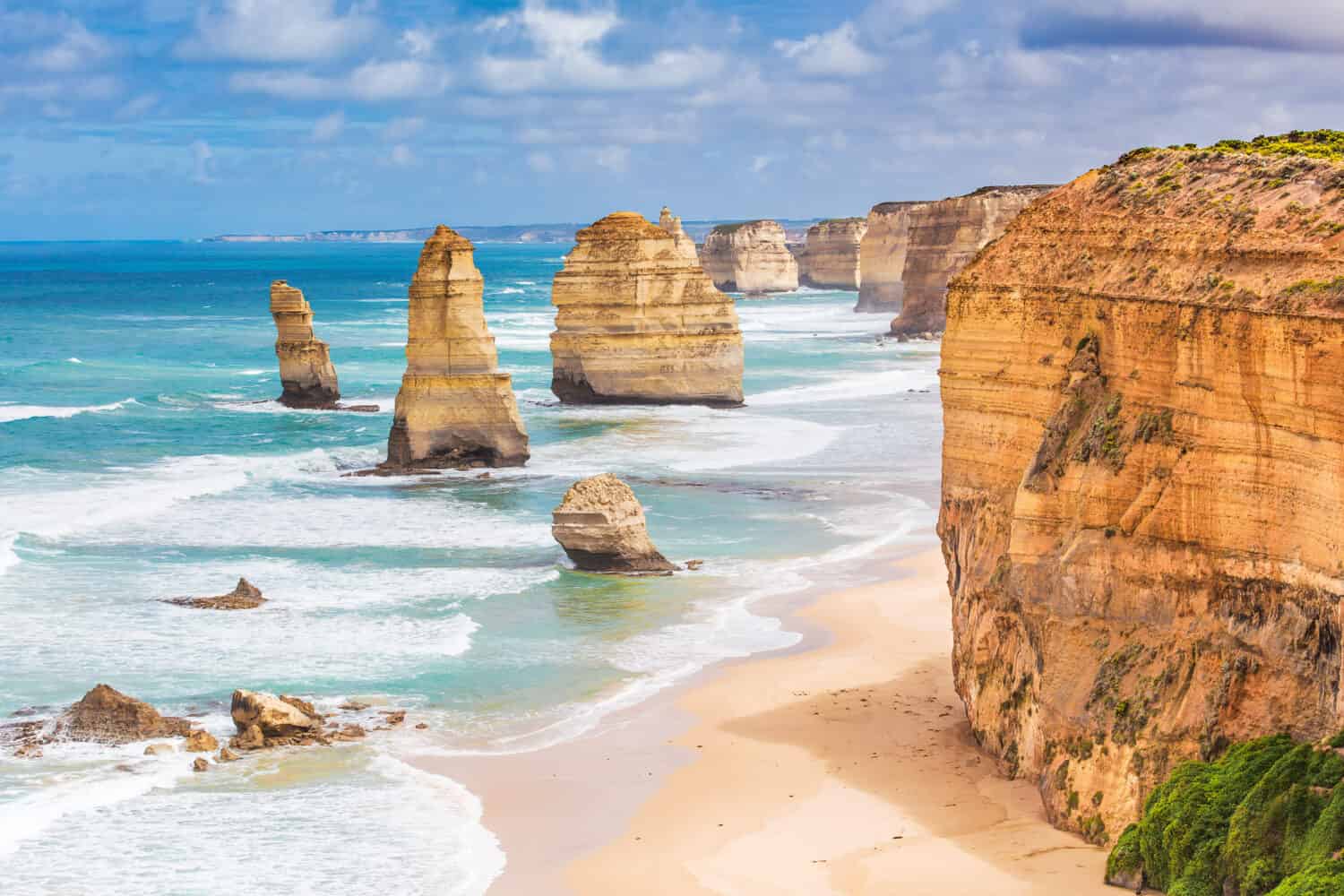
Visiting the Twelve Apostles is a mesmerizing experience, as they appear to change color with the shifting light.
©Greg Brave/Shutterstock.com
The Twelve Apostles, an enchanting natural wonder off the southern coast of Victoria, Australia, stands as a testament to the ceaseless work of nature’s sculpting hand. These towering limestone stacks, despite their name, were never actually twelve in number. Instead, they have been shaped and reshaped over the course of millions of years by the relentless forces of erosion. Carved from the mainland cliffs, these magnificent formations are a sight to behold, rising majestically from the Southern Ocean. Their history is one of continual transformation. In time, the limestone cliffs gradually eroded to create the stunning pillars that stand today.
Moreover, visiting the Twelve Apostles is a mesmerizing experience, as they appear to change color with the shifting light of the day. The rich hues of the limestone against the azure sea provide an awe-inspiring contrast. This site is part of the Port Campbell National Park, which boasts an array of other remarkable rock formations and natural features, including caves, arches, and gorges. The Twelve Apostles have become an iconic symbol of Australia’s diverse and striking natural landscapes. What’s more, they serve as a reminder of the profound beauty and the ever-changing face of our planet.
7. Giant’s Castle, South Africa
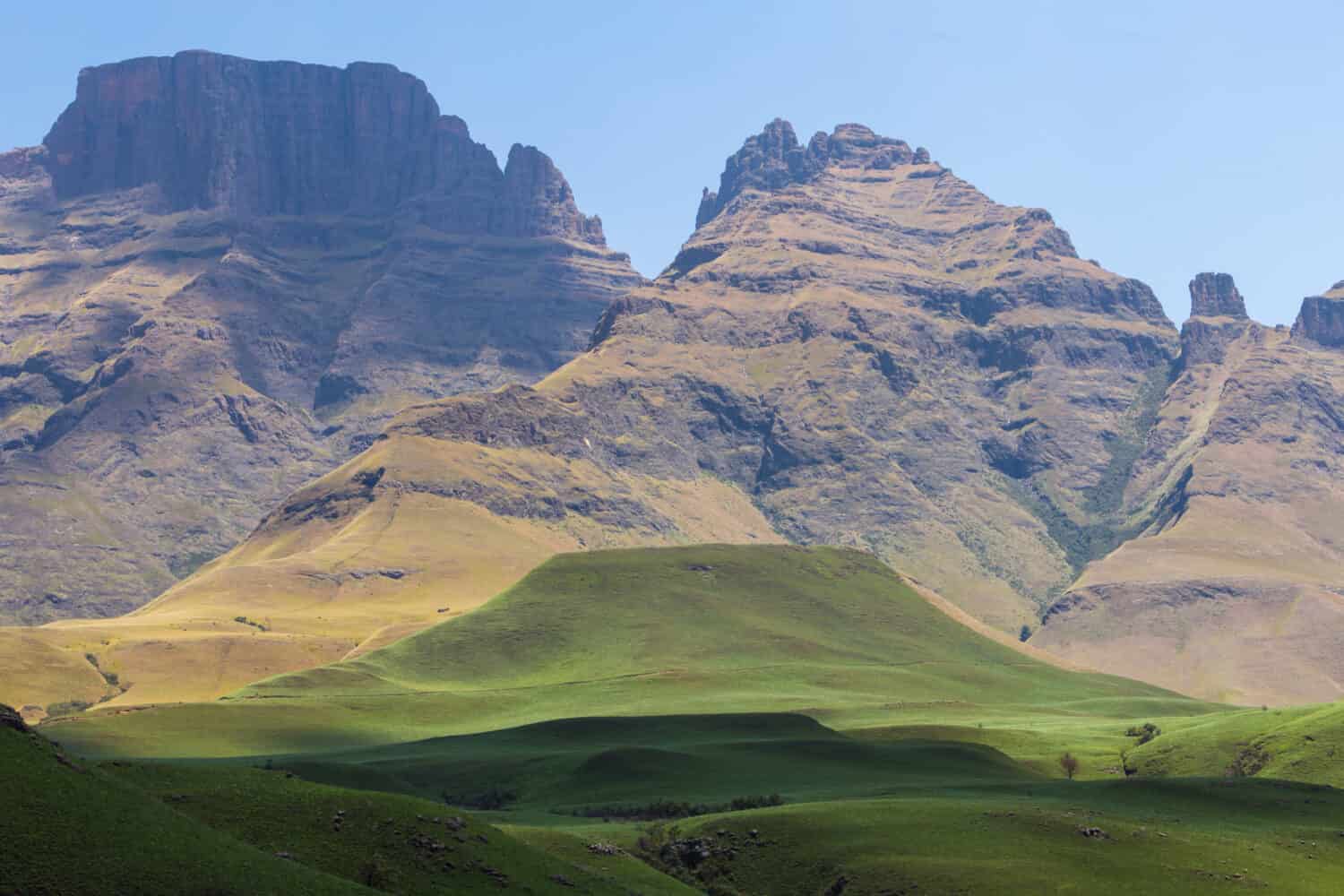
The Drakensberg Mountains, which nestle Giant’s Castle, have a rich geological history.
©Brendan van Son/Shutterstock.com
Next, a geological marvel that has captured the imaginations of visitors and scientists alike, this spectacular sandstone formation features striking peaks and cliffs. This landscape is the result of the dynamic interplay of geological forces over hundreds of millions of years. The Drakensberg Mountains, which nestle Giant’s Castle, have a rich geological history. The exposed rock formations in this region have contributed significantly to our understanding of Earth’s deep past.
What’s more, Giant’s Castle is more than just a geological formation; it is also a biodiversity hotspot. The area’s diverse flora and fauna thrive amidst the striking rock outcrops. This makes it an even more popular destination for hikers, nature enthusiasts, and conservationists. The region is home to a variety of wildlife, including eland, baboons, and the rare bearded vulture. Visitors to Giant’s Castle can explore its numerous hiking trails, marvel at the incredible vistas, and even discover ancient rock art left behind by the San people. In essence, Giant’s Castle stands as a testimony to the wonders of geological forces and the intricate ecosystems they nurture, all against the backdrop of the breathtaking Drakensberg Mountains.
8. Mount Everest, Nepal/Tibet

The world’s highest peak, Mount Everest, is 8,849 meters (29,032 feet) high.
©Martin Gillespie/Shutterstock.com
Mount Everest, the world’s highest peak, is a towering testament to the Earth’s geological history and the monumental forces of tectonic plate movements. Located on the border between Nepal and Tibet, this colossal mountain has been formed through the collision of the Indian and Eurasian tectonic plates over the course of approximately 60 million years. The result is a snow-capped behemoth that reaches a staggering height of 8,849 meters (29,032 feet) above sea level. As the ultimate challenge for climbers and an enduring symbol of human ambition, Mount Everest’s geological origins are a story of tectonic drama and the slow shaping of the Earth’s surface.
The allure of Mount Everest extends beyond its geological significance. It’s a beacon for adventurers and mountaineers from around the world, luring them with the promise of reaching the “roof of the world.” Furthermore, the Himalayan range, of which Mount Everest is the pinnacle, is a region of profound cultural significance and stunning natural beauty. It offers breathtaking vistas of high-altitude landscapes, unique ecosystems, and a sense of awe that has captivated explorers and mountaineers for generations. Finally, whether scaling its heights or admiring its majesty from afar, Mount Everest remains an enduring symbol of the Earth’s geological history and humanity’s ceaseless desire to conquer the unconquerable.
9. Antelope Canyon, USA
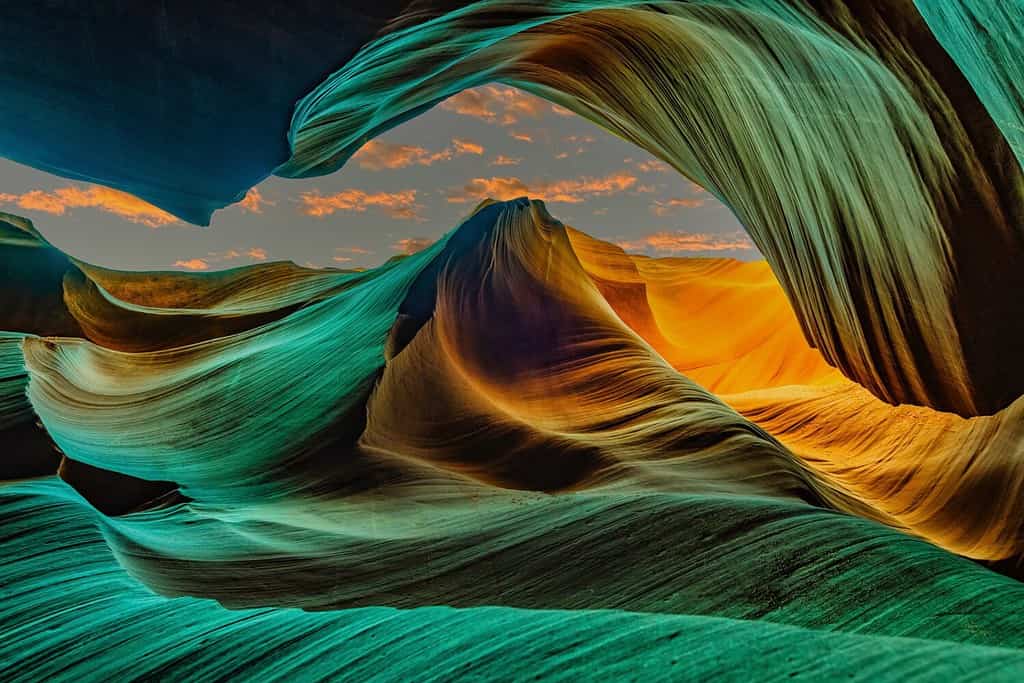
Antelope
Canyon is a living testament to the dynamic power of water.
©finepic/Shutterstock.com
Next, Antelope Canyon, located within the heart of the Arizona desert, is a geological wonder that features exquisite slot canyons. These narrow, winding passageways, with their ethereal, undulating walls, are a breathtaking testament to the power of water erosion and the dramatic forces of nature. Over thousands of years, flash floods and flowing water have meticulously carved their way through the Navajo sandstone. This resulted in the magnificent, winding corridors that have become a photographer’s paradise and a nature enthusiast’s dream.
Moreover, the slot canyons of Antelope Canyon, Upper, and Lower, famously offer a play of light and shadow that transforms their delicate, sculpted walls. The interplay of sunlight filtering down into the depths of the canyons creates a mesmerizing dance of colors and shapes. Moreover, visitors often witness beams of light piercing through the narrow openings above. This, in turn, illuminates the sandy floors and casts an enchanting, almost otherworldly glow. This natural marvel has become a must-visit destination for photographers, artists, and those seeking the serenity of nature’s artistry. Furthermore, Antelope Canyon is a living testament to the dynamic power of water and the intricate beauty created through millennia of patient carving and sculpting.
10. Caldera of Santorini, Greece

The age and formation of the Santorini caldera tell a story of the ever-changing nature of our planet.
©Feel good studio/Shutterstock.com
The caldera of Santorini, nestled in the southern Aegean Sea, is a breathtaking geological phenomenon. It also offers a glimpse into the volatile history of this picturesque Greek island. What we see today is the result of a colossal volcanic eruption that took place around 3,600 years ago, often referred to as the Minoan or Thera eruption. Furthermore, this eruption was one of the most significant in recorded history. The explosion not only dramatically reshaped the island but also contributed to the decline of the Minoan civilization on Crete. Over time, the collapsed volcanic caldera filled with seawater. This, in turn, created a breathtakingly deep and captivatingly blue caldera surrounded by the remnants of the volcanic rim.
The age and formation of the Santorini caldera tell a story of the ever-changing nature of our planet. Today, the Santorini caldera offers a unique and serene landscape with its dazzling waters and picturesque villages perched along the cliff edges. It is an inviting destination for travelers seeking to explore its natural beauty and the mysteries that lie beneath its azure surface.
11. Devil’s Tower, USA
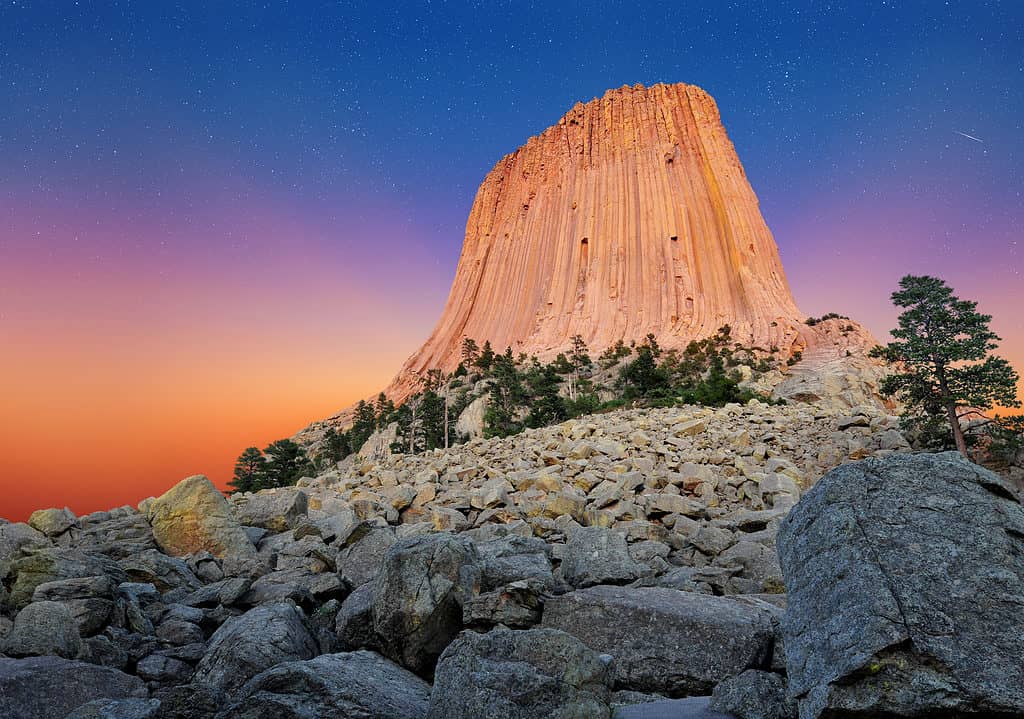
The tower’s Lakota name, “Mato Tipila,” translates to “Bear Lodge,” and it features prominently in their cultural and spiritual narratives.
©iStock.com/LaserLens
Following, Devil’s Tower is a striking igneous intrusion that soars skyward in northeastern Wyoming. It is a geological wonder with a history dating back around 50 million years. This monumental rock formation stands as one of the most iconic landmarks in the United States. Its distinctive appearance consists of hexagonal columns, reaching a height of approximately 264 meters (867 feet). Furthermore, what makes the Devil’s Tower even more fascinating is the geological process behind its formation. It’s speculated that it originated from molten rock, specifically igneous phonolite porphyry, which was forced into existing sedimentary rock layers. Over the ages, the softer sedimentary rock eroded, revealing the tower’s stunning columns.
Beyond its geological significance, Devil’s Tower also holds cultural importance. It has long been recognized as a sacred site for Indigenous peoples, including the Lakota Sioux, Cheyenne, and Kiowa. The tower’s Lakota name, “Mato Tipila,” translates to “Bear Lodge,” and it features prominently in their cultural and spiritual narratives. Moreover, the tower’s extraordinary columns have also made it a renowned destination for rock climbers from around the world. Again and again, they come to test their skills on its distinctive surface. Ultimately, the Devil’s Tower remains a striking testament to the intricate and diverse geological features of the United States and the cultural reverence it holds for Indigenous communities.
12. The Wave Rock, Australia
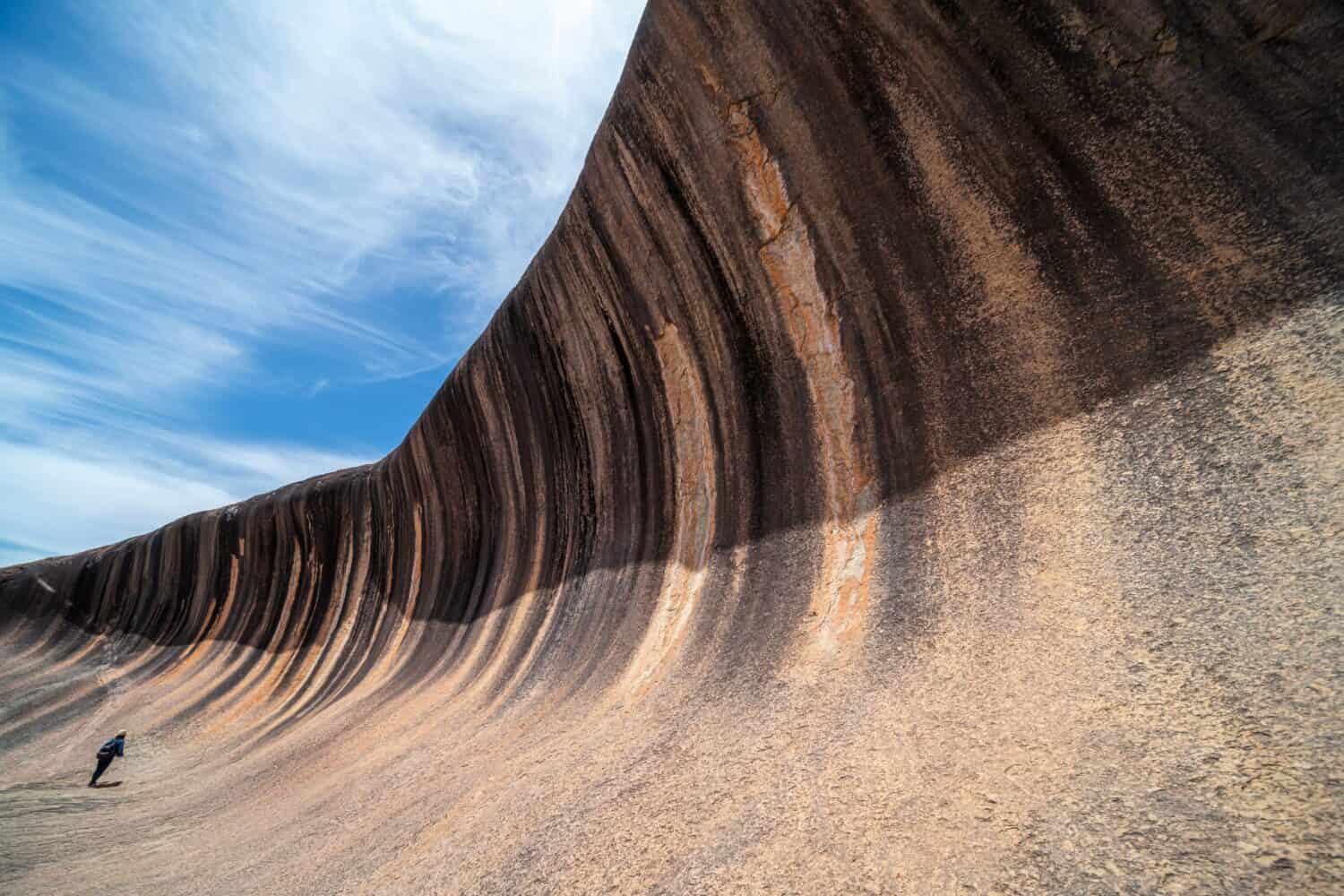
With its distinctive shape and curvatures, this rock is the result of millions of years of geological processes.
©anek.soowannaphoom/Shutterstock.com
The Wave Rock, a geological masterpiece located in Western Australia, is a testament to the incredible artistry of nature and the vast spans of time that have shaped our world. This unique rock formation resembles a massive breaking ocean wave. It is indeed a rare sight to behold in the arid Australian Outback. Moreover, Wave Rock is a product of nature’s patient handiwork. With its distinctive shape and curvatures, this rock is the result of millions of years of geological processes. It primarily consists of grey and red granite, contrasting sharply with the surrounding landscape and adding to its visual appeal.
Geologists believe that the formation of Wave Rock can be traced back over 2.7 billion years. What’s more, it was originally a part of a massive granite formation that extended underground. Erosion and weathering have gradually exposed this remarkable geological feature. Ultimately, Wave Rock is an enticing destination for travelers and adventurers looking to explore the extraordinary landscapes of Western Australia.
13. Moeraki Boulders, New Zealand
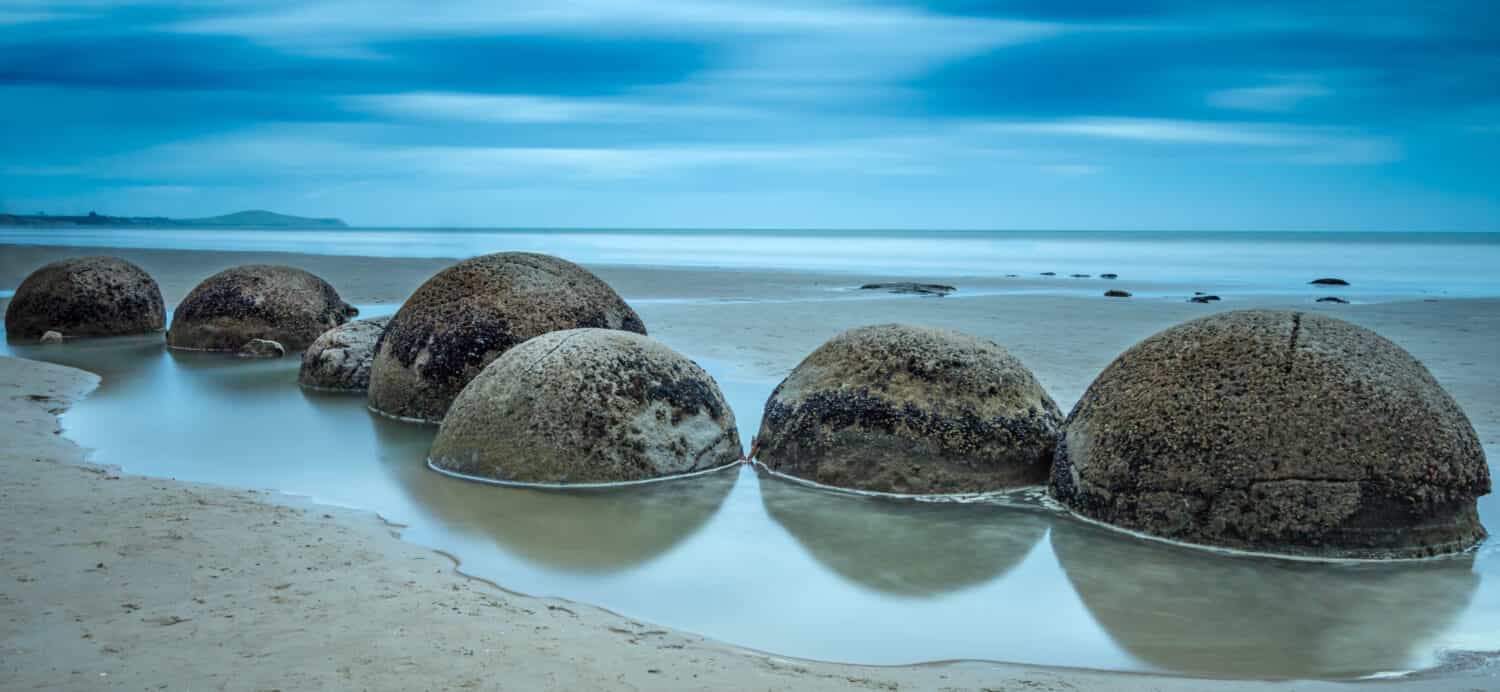
The Moeraki Boulders have become iconic features of the New Zealand coastline.
©Andy Cox/Shutterstock.com
Next, the Moeraki Boulders are a striking natural wonder. Scattered along Koekohe Beach on the east coast of New Zealand’s South Island, these enormous spherical stones have captured the imagination of visitors for centuries. What’s more, their formation is as fascinating as their appearance. These remarkable boulders were formed over 60 million years ago, with their origins traced to ancient sea sediments. Layers of sedimentary rock, minerals, and calcite gradually accumulated around a central core, creating these massive spherical structures. Moreover, the size of the boulders is truly remarkable. Some reach diameters of up to three meters (almost 10 feet)!
The Moeraki Boulders have become iconic features of the New Zealand coastline. What’s more, their mysterious appearance prompted various Maori legends and scientific studies. Furthermore, according to Maori legend, the boulders are remnants of the gourds, kumara (sweet potatoes), and eel baskets that washed ashore from the great Araiteuru canoe that carried the ancestors of the Ngai Tahu people to the South Island. These ancient geological marvels have inspired countless photographers, geologists, and nature enthusiasts. Ultimately, they serve as a poignant reminder of the Earth’s ever-evolving landscapes and the profound stories hidden within its rocks.
14. Table Mountain, South Africa

Table Mountain is more than just a geological wonder; it is also a biodiversity hotspot.
©Arnold.Petersen/Shutterstock.com
A flat-topped sandstone formation, Table Mountain is an iconic natural feature that graces the city of Cape Town, South Africa. This remarkable geological structure has a history that extends back around 360 million years. Naturally, this offers insights into the ancient processes that shaped our planet. The mountain’s distinctive shape, which resembles a colossal tabletop, was created through the gradual erosion and uplift of the surrounding rock layers. Over time, geological forces and weathering sculpted the sandstone into this unique and visually striking formation.
Furthermore, Table Mountain is more than just a geological wonder; it is also a biodiversity hotspot. The mountain is home to a wide range of plant species. Among these the rare and endangered silver tree, plus a variety of animal species, making it an ecologically significant site. Beyond its natural beauty and environmental importance, Table Mountain holds cultural and historical significance for the people of Cape Town. Moreover, it has been a source of inspiration and wonder for generations, with numerous legends and stories surrounding its formation. This extraordinary geological feature offers an amazing opportunity to appreciate both the Earth’s deep history and the natural beauty that surrounds it.
The photo featured at the top of this post is © Katrina Brown/Shutterstock.com
Thank you for reading! Have some feedback for us? Contact the AZ Animals editorial team.






